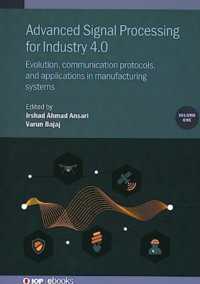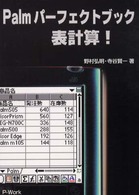- ホーム
- > 洋書
- > ドイツ書
- > Mathematics, Sciences & Technology
- > Chemistry
Full Description
Cutting-edge information about materials, technologies, and mechanisms of printed electronics, and their applications for the smart packaging
Printed Electronics for Smart Packaging describes how and why to use printed electronic devices for application in smart packaging.
Written by two highly qualified academics, Printed Electronics for Smart Packaging covers sample topics such as:
Applications of printed electronics, such as flexible screens, intelligent labels and packaging, interactive books and posters, and even upholstery
Mechanisms of smart packaging, printing methods and integrated strategies, and functional inks and substrates for smart packaging
Printed tracks for smart tags and IPES, printed optoelectronic devices and energy suppliers for smart packaging, and printed sensors and indicators
Integrated printed electronics systems, and expert outlooks and perspectives on potential future directions for research and development in the field
A must-have resource for anyone to expand the knowledge of the latest developments for intelligent packaging, Printed Electronics for Smart Packaging is an essential read for not just related academics but also various intersecting industries and professionals due to the importance of packaging in all market sectors.
Contents
Preface xi
Author Biography xiii
1 Introduction of Printed Electronics and Smart Packaging 1
1.1 Introduction 1
1.2 PE Technologies 2
1.2.1 What Is PE Technologies? 2
1.2.2 Why Should PE Technologies Be Developed? 2
1.3 Flexible PE Devices 4
1.4 PE for Smart Packaging 7
1.4.1 Food Packaging 7
1.4.2 Drug Packaging 8
1.4.3 Smart Logistics and Supply Chain 9
1.5 Content and Structure of This Book 10
References 11
2 Mechanisms and Strategies of Smart Packaging 13
2.1 Introduction 13
2.2 Active Packaging 15
2.2.1 Moisture Regulators 15
2.2.2 Modified Atmosphere Packaging 16
2.2.3 Ethylene Scavengers 17
2.2.4 Antimicrobial Active Packaging 18
2.2.5 PCMs-Based Active Packaging 20
2.3 Intelligent Packaging 21
2.3.1 Indicator Technology for Packaging 21
2.3.1.1 Freshness Indicators 22
2.3.1.2 Time-Temperature Indicators 23
2.3.1.3 Temperature Indicators 25
2.3.2 Sensors for Smart Packaging 27
2.3.2.1 Classification and Principle of Sensors 27
2.3.2.2 The Important Characteristics of Sensor 35
2.3.3 Wireless Communication Technologies in Packaging 37
2.4 Why You Need to Use PE? 39
References 41
3 Printing Methods and Integrated Strategies 47
3.1 Introduction 47
3.2 Conductive Mechanism of Printed Electronic Inks 48
3.3 Manufactural Process of PE Devices 50
3.3.1 Screen-Printed Electronic Technologies 51
3.3.2 R2R Printed Electronic Technologies 53
3.3.2.1 RSP Technology 54
3.3.2.2 Gravure Printing Technology 55
3.3.2.3 GOP and ROP 58
3.3.2.4 Flexographic Technology 60
3.3.3 Inkjet Printed Electronic Technologies 62
3.3.3.1 The Inkjet Printing Methods 62
3.3.3.2 The Challenges of Inkjet Printing Technologies 65
3.4 Postprinting Process 66
3.4.1 Sintering for Flexible Electronics and Smart Packaging 67
3.4.2 Sintering Methods 68
3.5 Techniques and Parameters for PE 70
3.5.1 The Influence of Geometric Dimensions on PE Devices 71
3.5.2 The Influence of Patterning Design 72
3.5.3 The Impact of Geometric Dimensions and Patterning on the
Manufacturing Process 73
References 74
4 Functional Inks and Substrates for Smart Packaging 83
4.1 Introduction 83
4.2 Conductive Inks and Pastes 86
4.2.1 Silver Conductive Inks 87
4.2.1.1 Commercial Ag Pastes 87
4.2.1.2 Ag Nanomaterials-Based Conductive Inks 89
4.2.1.3 Ag-Based Composite Inks 92
4.2.2 Copper Conductive Inks 94
4.2.2.1 Commercial Cu Pastes 94
4.2.2.2 Cu Nanomaterials-Based Inks 95
4.2.3 Other Metal Conductive Paste Inks 95
4.2.3.1 Bimetallic Conductive Inks 96
4.2.3.2 Liquid Metals 97
4.2.3.3 MXene 100
4.2.4 Carbon Inks and Pastes 103
4.2.4.1 CNTs-Based Conductive Inks 103
4.2.4.2 Graphene-Based Conductive Inks 104
4.2.5 Particle-Free Inks 107
4.2.6 Organic Conductive Inks 110
4.3 Printable Semiconductors and Insulator Inks 112
4.3.1 Semiconductor Inks 112
4.3.1.1 Inorganic Semiconductor Inks 112
4.3.1.2 Organic Semiconductor Inks 116
4.3.2 Insulator Inks 118
4.4 Conventional Substrates for PE Devices and Smart Packaging 119
References 121
5 Printed Tracks for Smart Tags and Packaging 131
5.1 Introduction 131
5.2 Printed Tracks, Interconnected Circuits, and Printed Antennas 133
5.2.1 Flexible Conductive Electrode and Printed Tracks 133
5.2.2 Conductive Patterns and Interconnected Circuits 135
5.2.3 Printed Flexible Antennas in Smart Tags 138
5.3 Printed Flexible Transparent Electrodes 140
5.3.1 Printing the Transparent Conductive Films 140
5.3.2 Printing the Conductive Metal Grids/Mesh 142
5.4 Printed Stretchable Electrodes and Stretchable Interconnects 143
5.4.1 The Selection of Conductive Materials and Ink Preparation 144
5.4.2 Structural Design Optimization 147
5.5 Printed Flexible Heaters for Self-heating Packaging 148
5.5.1 The Fabrication of PFHs 148
5.5.2 The Application of PFHs in Self-heating Packaging 150
References 152
6 Printed Optoelectronic Devices and Energy Suppliers for Smart Packaging 161
6.1 Introduction 161
6.2 Printed Optoelectronic Devices 163
6.2.1 Printed Flexible Thin-Film Transistors 163
6.2.2 Printed Displays for Information Outputs 167
6.3 Printed Energy Devices for Smart Tags and IPES 171
6.3.1 Printed Flexible Solar Cells 172
6.3.1.1 Copper-Indium-Gallium Selenide Printed Flexible Solar Cells 172
6.3.1.2 Organic PFSCs 173
6.3.1.3 Perovskite PFSCs 174
6.3.2 Printed Supercapacitors 176
6.3.2.1 The Mechanisms of Supercapacitors 176
6.3.2.2 Printing Methods for Flexible Supercapacitors 178
6.3.3 Flexible Printed Batteries 182
6.3.3.1 Printed Lithium-Ion Batteries 183
6.3.3.2 Printed Sodium-Ion Batteries 185
6.3.3.3 Printed Zn-Ion Batteries 187
6.3.4 Flexible Printed Generators 190
6.3.4.1 Printed Triboelectric Nanogenerators and Printed Piezoelectric Nanogenerators 191
6.3.4.2 Printed Hydrovoltaic Generators 194
References 197
7 Printed Sensors and Indicators 207
7.1 Introduction 207
7.2 Printed Force Sensors 209
7.2.1 Printed Strain Sensor 210
7.2.2 Printed Pressure Sensor 214
7.3 Printed Temperature and Humidity Sensors 217
7.3.1 Printed Temperature Sensor 218
7.3.2 Printed Humidity Sensor 220
7.4 Printed Piezoelectric and Triboelectric Sensors 223
7.4.1 Printed Piezoelectric Sensor 224
7.4.2 Printed Triboelectric Sensor 225
7.5 Printed Gas Sensors 227
7.6 Printed Time-Temperature/Gas/Freshness Indicators 232
7.6.1 Printed Time-Temperature Indicators 232
7.6.2 Printed Gas Indicators 234
7.6.3 Printed Freshness Indicators 235
References 238
8 Integrated Printed Electronics Systems 247
8.1 Introduction 247
8.1.1 What and Why Is Integrated Printed Electronics Systems 247
8.1.2 Challenges Faced by IPES 248
8.1.2.1 High-Performance PE Materials 249
8.1.2.2 Stability and Durability 249
8.1.2.3 Electronic Packaging 250
8.1.2.4 System Design and Effective Integration of Different Components 250
8.1.3 Integration Methods for IPES 251
8.1.3.1 Single-Sided IPES 251
8.1.3.2 Double-Sided IPES 252
8.1.3.3 Multilayer IPES 252
8.1.4 The Applications of IPES in Smart Packaging 252
8.2 Printed Multisensor Platform 253
8.2.1 Advantages of Multisensor Integration 253
8.2.2 Challenges of Multisensor Integration 254
8.2.3 The Integration of Printed Force Sensors 255
8.2.4 The Integration of Printed Force and Temperature Sensors 256
8.2.5 Printed Sensor Array 257
8.3 Wireless Sensor Platforms 261
8.3.1 Common Wireless Transmission Technologies and Their Characteristics 261
8.3.1.1 Zigbee 261
8.3.1.2 Bluetooth 262
8.3.1.3 Wi-Fi 262
8.3.1.4 Ultra-Wideband 262
8.3.1.5 Radio Frequency Identification and Near-Field Communication Technology 262
8.3.2 Printed Sensors with Wireless Communication 263
8.4 E-skin 268
8.5 Self-powered IPES 271
8.6 IPES Tags for Smart Packaging 273
8.6.1 RFID/NFC Tags 274
8.6.2 IPES Tags 277
References 278
9 Outlooks and Perspectives 283
9.1 Introduction 283
9.2 The Consensus of Smart Packaging 284
9.3 Printed Electronics Technology's Advantages in Manufacturing Smart
Packaging Products 286
9.4 Application Scenarios-Driven Smart Packaging Implementation 287
References 289
Index 291








